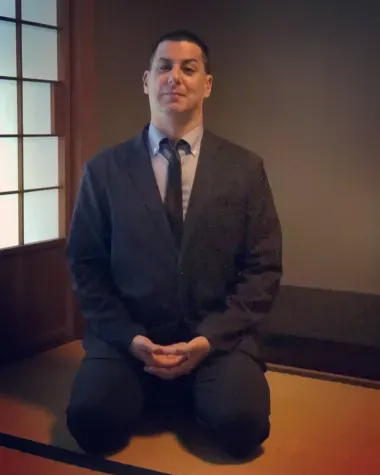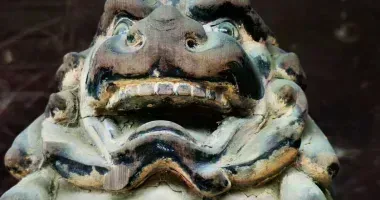Let's Zazen, by Jake Adelstein
- Published on : 12/06/2020
- by : Jake Adelstein - Tempura

Let's Stay Zazen by Jake Adelstein and Tempura Magazine
Tempura Magazine
Mindfulness meditation according to Jake Adelstein, or how zazen can help us live our daily lives more serenely.
Who said Zen was only for Buddhist monks? Jake Adelstein, the author of Tokyo Vice who has lived in Tokyo for more than thirty years, shares his practice of mindful meditation, zazen.
I spent a good part of my confined time doing Zen meditation. I am a Soto Buddhist priest, whose tradition dates back to the 12th century, when Dogen Zenji, its founder, brought the teachings from China. For the record, I'm not a very good priest. When you hear the word "Zen", you probably think of Steve Jobs and minimalist design, phrases like " what does one hand clapping sound like? ", or monks with shaved heads sitting in a lotus position and chanting incantations to achieve enlightenment.
Zen (禅) simply means "meditation", and Zen Buddhism is Buddhism with an emphasis on meditation to achieve inner peace and freedom from desire. Zen is also synonymous with mindfulness. Mindfulness and meditation are among the twelve acts of the historical Buddha, Shakyamuni.
Ideally, Zen should not be detached from the ethical traditions that gave birth to it. They are great tools for becoming a Buddha, which simply means "one who is awakened". Most of us are not awake. We don't experience the world as it is, but rather as we imagine it to be.
Dogen Zenji, the founder of Soto Buddhism, summed it up this way:
"There is a very simple path to becoming a Buddha. When you renounce evil deeds, no longer attach to birth or death, show compassion towards sentient beings, respect your elders and love the younger ones, that you neither exclude nor desire anything, without calculations or fears, then you will be called Buddha. Do not pursue anything else."
I would like to state here that during the coronavirus lockdown when we were all acutely aware of our mortality, I sought nothing but enlightenment. But of course, I'm not ready to become a Buddha. So when I wasn't meditating, I spent a lot of time with a German nurse who was on a working holiday in Tokyo. In a way, it was as calming as Zen meditation. I'm sure Dogen would approve. Or maybe not. But my Zen master was ok – and that's probably why he's my master. We get along well. The world on pause allowed me to renew my practice.
Zazen, or sitting meditation, is the heart of the teaching. Monasteries have their rules on how to practice zazen, but you don't need them. Rituals are important, of course, but what ultimately matters is the practice. I meditate most of the time in the large tatami room which also serves as my office and bedroom. I feel like I've arrived somewhere in the world when I compare all this space to my first bedroom in Japan. Of course, as a mendicant monk, I don't aspire to get anywhere. But the space is nice.

Let's Stay Zazen by Jake Adelstein and Tempura Magazine
©TEMPURA
For your good, I will take a moment to explain to you how to practice zazen.
Sit facing the wall with a small cushion under your buttocks. Put your right foot on your left thigh, and your left foot on your right thigh – if you can manage it. Half a lotus will do just fine. Or take a chair. Align your nose with your belly, stand up straight but relaxed. Keep your eyes half-closed and look down. Place the back of your left hand in the palm of your right hand. Your thumbs should lightly touch each other. Kind of like holding an egg in your hands. Exhale deeply through your mouth, and inhale through your nose. Repeat two or three times until you feel some sort of calm. And breathe normally.
Your mouth is closed, your eyes are open, you stand straight and are aware, but you do not aspire to achieve anything or to become a Buddha. Dogen believed that when you meditate, you are already a Buddha, in a way. Focus on your breathing. When noises reach you, record them. If thoughts come to you, let them pass and then return to your breathing.
If you start daydreaming, which is likely to happen, don't be too hard on yourself. Come back to your breathing. Be in the moment. Beginners are sometimes told to count their breaths. It's not bad to start. Inhale, one. Exhale, two. Repeat. Breathe calmly through your nose. (If you have a cold, it's ok to breathe through your mouth). Don't try to control your breathing. Let it come so naturally that you forget you are breathing.
You are focused on your breathing, and whatever is happening around you becomes part of your meditation. A passing car, the creaking of the shutters when the wind blows. Notice them, let them go, and come back to your breath and embrace every moment. 10 to 20 min is more than enough.
When you have finished your zazen, join your hands at the chest and bow. Take a moment to express your gratitude: to the world, to your family, to your loved ones, and to the incredible chain of circumstances that allowed you to be born as a human. Take a long breath, straighten your legs and move very slowly. Your legs are probably asleep, and getting up can be perilous. Landing on your butt can compromise this newly acquired calm: take it easy.
Zazen produces several rather beneficial things. It physically changes your brain structure giving you more self-control. It helps you sleep better. When you apply it to your daily life, it helps you stay calm in stressful situations. The mind of a Zen monk during and after meditation works in harmony. A study conducted by the University of Wisconsin in 2005 shows that during meditation, the waves of different areas of the brain work in great synchrony. And this synchrony can last a very long time.
Zazen doesn't just provide relaxation, it helps you stay calm and alert to the world around you.
An important point here. The benefits of Zen meditation, which are good to know, should not be pursued as a goal in itself. I know it sounds contradictory, but one of the goals of zazen is to free yourself from desire. So if all you want is to get the benefits of meditation, you won't be able to meditate or get them. So relax.
Sawaki Kodo, a somewhat iconoclastic great master of Zen Buddhism who died in 1965, was once asked, "What is zazen for? " Here is his answer: "Zazen is useless. If that is enough for you, and if you do what is useless with all your heart, then your practice will be really good for nothing.” Kodo had a good sense of humor, although he was a good-for-nothing Zen master.
During these moments of fear and tragedy brought by the coronavirus, I remembered the words of another Zen master. Unmon Zenji once summed up life after enlightenment in a simple phrase: Nichi Nichi Kore Kojitsu, "every day is a good day". I now understand the wisdom of this sentence every time I meditate. The fact that I'm sitting alive, and not dying of a terrible virus, is something I'm grateful for.
Every day is a good good-for-nothing day – that's something I can do with all my heart. Every day is a good day for zazen. When you're done reading this, try it yourself. But don't try too hard, just relax...
Good luck! You will be enlightened before you know it.
An article published in Tempura N°2, the quarterly magazine on the cultures of Japan, available in kiosks, bookstores, and on www.tempuramag.com
For further :
- Zen, a school of Japanese Buddhism
- Rejuvenate with Zen
- The Sôji-ji sô-in temple, where the monks offer zazen meditation sessions.
- The Eiheiji temple, dedicated since its origins to the practice of zazen
- Where to do a spiritual retreat near Tokyo?
- Where to do a spiritual retreat in Japan?










